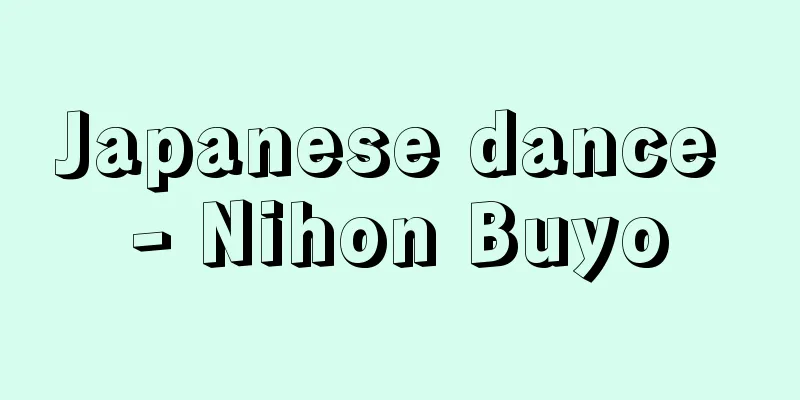Japanese dance - Nihon Buyo

|
It is also called Hobui and is broadly classified as Western dance (Western dance). In a broad sense, it refers to Bugaku (traditional dance), Noh (Nou), Kabuki (Kabuki) dance (classical dance), new dance, creative dance, folk dance (regional dance), etc. In a narrow sense, it often refers to Kabuki dance, which is the more commonly known of these. The word "dance" became widespread after 1904 (Meiji 37) when Tsubouchi Shoyo published "Shin Rakugekiron" (The Theory of New Music Drama); before that, words such as Mai (dance), Odori (dance), Shosagoto (movement), Furigoto (furigoto), Keigoto (scenery), and Butoh (dance) were used depending on the situation. [Kisaragi Aoko] AncientReligious elements can be seen at the beginning of all dances, and in Japan, its roots can be found in "Kagura," a dance performed in front of the gods to appease the souls of the dead. This can be traced back to the myth of Ame-no-Uzume-no-Mikoto's cave in heaven. In ancient times, rhythmic movements were called "mai," which meant "to spin." Ancient dances include "Kumemai," which is said to have originated from a song by the Kumebe during Emperor Jimmu's eastern expedition of Yamato, "Tamai" (Tamai), which originated from rice field events, "Yamatomai," which was performed throughout the Yamato region, "Hayatomai" by the Hayato people in the Satsuma region, "Azumaasobi" in the eastern region, "Kishimai" by people who served in the navy, and "Gosechimai," a female dance. In ancient countries, regional dances were presented by local powerful families along with military forces and products, and some of these were organized and preserved in the imperial court. In addition to these traditional Japanese dances, foreign dances were added from the Nara to Heian periods. First, in 612 (20th year of the reign of Empress Suiko), the silent drama "Gigaku" using masks was introduced by Mimashi, an immigrant from Baekje. Music and dance were also introduced from Bohai (northeastern China), the Three Kingdoms (Korean Peninsula), and Tenjiku (India), mainly from the Tang Dynasty, and these were adapted to the Japanese style to become the representative court dance "Bugaku" (a dance accompanied by "Gagaku", but they are generally considered to be the same). In 671 (10th year of the reign of Emperor Tenchi), Tian Yan was performed in front of the emperor, in 698 (2nd year of the reign of Emperor Mommu), Bugaku became the ceremonial music of the imperial court, and in 701 (1st year of the reign of Emperor Taiho), the Gagaku Ryo was established in the imperial palace. In 735 (Tenpyo 7), "Sangaku" was already introduced from China. This was a popular pastime of acrobatics, magic, and comical impersonations, and was corrupted to "Sarugaku" in the mid-Heian period. It later spread to vulgar arts, and on the other hand, led to the establishment of "Sarugaku Noh" in the Middle Ages. Most of today's Gagaku was perfected during the Heian period, and has been performed at the Imperial Court and shrines for annual events and ceremonies. The Gagaku Bureau is now the Music Department of the Imperial Household Agency, and is responsible for teaching and performances. Gigaku reached its peak around the time of the opening ceremony of the Great Buddha of Todaiji Temple (752) and disappeared during the Kamakura period, but its influence can be seen in folk dances such as the lion dance. [Kisaragi Aoko] middle agesAncient Bugaku developed in various ways during the Muromachi period. These included "Ennen," a dance and song performed by monks and young boys as entertainment after Buddhist ceremonies at temples; "Dengaku," a dance and music that originated in farming; "Shirabyoushimai," a dance performed by courtesans to popular songs such as Imayo; and "Kowakamai," a dance sung to war tales. "Male dances" performed in men's clothing became popular for Shirabyoushimai, and this trend led to "Kusemai," "Onna Sarugaku," and "Onna Kabuki." Sarugaku Noh was born from Sarugaku, and Dengaku, which incorporated techniques from Sangaku, was refined from "Dengaku Dance" to form a dance, and "Dengaku Noh" was created. During the Muromachi period, Kan'ami and Zeami, father and son of Yamato Sarugaku, refined Sarugaku Noh with the support of the Muromachi Shogunate, and perfected Noh as a musical drama. The emphasis on dance elements (mai) had a major influence on dance in general later on. In addition, Furyu, a group dance performed in the streets dressed in extravagant décor, showed an important development from the end of the Muromachi period to the early modern period, when the common people rose to power. Eventually, Kabuki dance (early Kabuki) was born from the refined form of Nenbutsu dance, which involved chanting Buddhist prayers and beating gongs and drums. Until the Middle Ages, dance was called "mai" (dance), except for Dengaku dance, but from the early modern period, the word "odori" (dance) was replaced by this. There are many types of folk dance, including Kagura (such as Miko Kagura), Dengaku (such as Den'an), Furyu (such as Nembutsu dance), Shukufukugei (such as Senzu Manzai), and Naritai (such as Kōwakamai), as well as imported types such as lion dance, and those in the style of Noh, Kyogen, puppet theater, and Kabuki, and these have been handed down to the present day in a variety of forms. [Kisaragi Aoko] Early modern periodIn the Edo period, the era of Kabuki dance, which was born and raised among the common people, began, replacing the Bugaku and Noh that had been protected by aristocrats and samurai. It was characterized by the absence of masks, the use of shamisen music as the main focus, and the incorporation of traditional dance and Bunraku puppet theatre techniques into the "dance," and the inclusion of a strong emphasis on "furi," which is a rhythmic form of imitation. The Nembutsu dance of Izumo no Okuni, which is said to be the source of this, became popular in Kyoto in 1603 (Keicho 8) with its "Kabukitaru Sugata." After the banning of "female Kabuki" and "young man Kabuki," the theatrical content became more complex, and in the Genroku period (1688-1704), dance became a part of Kabuki as "Shosagoto." The prominent form was the ghosts of the living and the dead expressing their grudges, and the performances included quick costume changes and acrobatic "keren" tricks. The representative young female actor of this era, Mizuki Tatsunosuke I, is famous for his plays "Neko no Shosaku" and "Yari Odori" as well as "Nanabake", the origin of the transformation story. Kabuki dance from the Kyoho to Horeki eras (1716-1764) was Nagauta dance, which was exclusively performed by female actors. The first generation of famous female actors, Segawa Kikunojo, from Kamigata, produced works such as "Keiseidojoji" (1731) and "Aioijishi" (1734), and Nakamura Tomijuro's "Kyoganokomusume Dojoji" (1753), which drew inspiration from the earlier art of Noh but added the appeal of Kabuki dance. The absence of women was established as a major characteristic by confining the male body in costumes with long hems, sleeves, and obi. From the Tenmei to Kansei eras (1781-1801), the center of Kabuki shifted from Kyoto and Osaka to Edo, and the advancement of leading actors into Kabuki dance, which had previously been dominated by female actors, became noticeable. In music, the Bungo-bushi style was replaced by the Tokiwazu and Tomimoto styles, and dramatic dance with strong dramatic elements became popular. The person who perfected this style was Nakamura Nakazo I, who produced masterpieces of Joruri Shosagoto, including "Seki no Tobira" (1784) and "Modorikago" (1788). These were included in the Edo Kaomise Kyogen, and the structural convention of including dance scenes in Joruri encouraged the development of dramatic dance, and at the same time, specialized choreographers became active. In the Bunka and Bunsei eras (1804-1830), Kabuki dance saw a decline in dramatic dance and a flourishing of "hengamono," a suite-style dance in which several short pieces were danced one after the other. The hengamono style began with the aforementioned Mizuki Tatsunosuke, but works from the Bunka era moved away from the early "onryogoto" (vengeful spirit) character and showed a wide variety in both music and characters. In 1814 (Bunka 11), Tomimoto-bushi gave rise to Kiyomoto-bushi, and the Edo chic was also well received. Bando Mitsugoro III and Nakamura Utaemon III are representative of this era, and they were particularly known for their depictions of the customs of the common people. Today, only one complete piece remains, "Rokkasen" (1831), but there are countless variations from this period that are loved as independent pieces, such as "Fuji Musume," "Echigo Jishi," and "Tomoyakko." At the end of the Edo period, festival pieces and comedic pieces were prominent, such as the stylish masterpiece "Sanze Sounishikibunsho" and the lively folk dance "Noriaisen." As mentioned above, Kabuki dance developed in the theaters of Edo, whereas there is "Kamigatamai" which was formed in Kyoto and Osaka around the Bunka and Bunsei eras and developed after the end of the Edo period. It originated from the aforementioned Noh dance and Gotenmai which was passed down among the Imperial Court and courtiers, and was developed by incorporating puppets from Bunraku puppet theater and the choreography of Kabuki dance. Depending on the school, there are various Kabuki plays performed on the theater stage, but they share many common pieces with jiuta (songs) and are centered around zashiki-mai (traditional Japanese dance). For this reason, it is also called "jiutamai" (Jiuta dance), and the form that was developed in Kyoto is called "Kyoto dance". [Kisaragi Aoko] After the Meiji PeriodIn the Meiji era, a succession of works based on the more open-minded "Noh" were produced, and a trend toward sophistication was apparent. Representative figures were Ichikawa Danjūrō IX and Onoe Kikugorō V, including "Renjishi," "Funabenkei," "Tsuchigumo," and Kyogen-based works such as "Suōotoshi" and "Tsurionna." However, Kabuki dance was in a state where new developments could not be expected during the Meiji era, and the rapid social changes of the time called for fresh air in the world of dance as well. In 1904 (Meiji 37), Shoyo Tsubouchi published "New Theory of Music and Drama," and in the Taisho period, the New Dance Movement, which inherited his vision, began. This opened the way for dancers to become independent professionals and perform on stage. In 1917 (Taisho 6), Fujima Shizue (Fujikage Shizue, later Seiju) founded the Fujikage Society, which was followed by Hanayagi Tokuji (Gojo Tamami), Umemoto Rikuhei (1896-1985), the 2nd Ichikawa Ennosuke (Saruon), the 5th Nakamura Fukusuke, and the 7th Onoe Eizaburo (1900-1926), and the 2nd Hanayagi Jusuke (Juou) also founded the Hanayagi Dance Research Society in 1924. In 1930 (Showa 5), Hanayagi Sumi, Fujima Harue (later Harue, Azuma Tokuho), Nishizaki Midori, Fujima Kansōga (1910-2000), and others joined the group. New dance pieces began to be produced by dancers rather than kabuki actors. In the Taisho and Showa periods, the dance of the Kabuki world was dominated by the traditional style of Bando Mitsugoro VII and the modern style of Onoe Kikugoro VI, while Ichikawa Ennosuke II stood out for his contributions to new works. [Kisaragi Aoko] After World War IIDuring the post-World War II reconstruction period, works that were heavily influenced by ballet, modern dance, and American jazz stood out. Also, the second-generation Nishikawa Koisaburo transformed literary works into dance, which created a period. The geisha dance "Azumaodori," which has a history dating back to the end of the Taisho period, also flourished for a time. Groups were formed and performed across schools, and the Kamigata dance "Azuma-odori" also became popular. In terms of creative activity, Hanayagi Tokubei stood out, with his representative postwar masterpiece "Doukoku" (1953). In the same 1950s, Yoshimura Yuki's "The Stork" (1959) also attracted attention. Hanayagi Juraku (1918-2007), Toshinami (1924-2018), Shigeka (1926-2016), and Teruna (1929-2005), who continued to produce works into the 1980s, as well as Izumi Tokuemon (1924-1991), Hanayagi Sueyuki (1925- ), Takahama Ryū Mitsutae (1923-2005), Nishikawa Senzō 10th, and Fujikage Shizue 2nd, among others, also produced unique and excellent works. Other notable works include Azuma Tokuho's "Akai Ko" (1967) and "Fujito no Ura" (1969), and Takehara Han's "Ohara Goko" (1976). In 1966, the first National Theatre was established in Tokyo, and in 1984, the National Bunraku Theatre was established in Osaka. Both of these theaters hosted independent performances of various forms of Japanese dance, and also held numerous "dance appreciation classes" and "trajectories of Japanese dance" to help audiences understand the art. As for personal activities in this field, Hanayagi Junankai's "Junankai and the Dance Study Group" has continued its long journey of 50 performances. Hanayagi Chiyo (1924-2021) wrote a book called "The Basics of Japanese Dance" and held seminars on basic practice, some of which were held overseas. As of 2015, the 7th Bando Mitsugoro, Hanayagi Juo, the 6th (7th in name), Fujima Kanjuro, Yamamura Taka, Yoshimura Yuki, Fujima Fujiko, the 4th Inoue Yachiyo (Inoue Aiko), Hanayagi Juraku, the 10th Nishikawa Senzo, Hanayagi Junankai, and the 5th Inoue Yachiyo have been individually designated as Important Intangible Cultural Properties (Living National Treasures). Hanayagi Junankai, the 7th Bando Mitsugoro, the 1st Fujikage Shizue, the 6th Fujima Kanjuro, Takehara Han, Azuma Tokuho, Yoshimura Yuki, and the 4th Inoue Yachiyo have all been designated as Persons of Cultural Merit, and of the above, the 6th Fujima Kanjuro and the 4th Inoue Yachiyo have been recipients of the Order of Culture. [Kisaragi Aoko] Types and Structure of Kabuki DanceKabuki dance developed as a part of Kabuki, and its development was encouraged by the long-standing custom of including a dance scene in every Kyogen performance during the Edo period. Many of the works are broadly divided into those with strong theatrical qualities (dramatic dance) and those with little drama. Depending on the subject matter and style, they are divided into many types, such as "Sanbaso-mono," "Asama-mono," "Dojoji-mono," "Stone Bridge-mono," "Michiyuki-mono," "Kyouran-mono," "Yamanba-mono," "Henge-mono," "Matsubame-mono," and others. In terms of the performance format, they are divided into various ways, such as "Ritual Dance," "Kaomise-buyo," and "Ogiri-shosagoto," and by the music used, "Nagauta-mono" and "Joruri-mono" (there are also works that combine Nagauta and Joruri). Therefore, there are many cases where one work is included in several classifications. The structure of Kabuki dance is based on the following format: Oki (Okiuta, Okijoruri) = A section in which no characters appear but only music. De (Debata) = the appearance of a person. It can also refer to a journey along the Hanamichi path. Kudoki , or storytelling (monogatari) = Kudoki is the highlight of the performance, as the female role dances to express her love for the male or her deepest feelings. The male role dances a narrated military tale. In the case of a brothel tale, two people may dance separately. Odori-chi = lively musical instruments are included, and there are hand dances (without holding anything), group dances, etc. Also called Taiko-chi. Kyū Chirashi (end of stage) = the end. The ending can be a mie or kimari pose on stage, or a hakikomi on the runway. However, there are also various irregular works, such as those that have no oki. Kabuki dance, which has been the longest-running form of Japanese dance and has produced many works, has a vulgar flavor because it was supported by and developed among the townspeople class. Its character is in stark contrast to Noh, which developed under the patronage of the aristocratic and samurai classes. It is also based on shamisen music, and has a strong element of impersonation based on the lyrics. Other characteristics include the sex appeal of the female actors and the red-light district atmosphere. Today, Kabuki dance is performed and passed down by Kabuki actors and dancers. [Kisaragi Aoko] schoolThere are many schools of Japanese dance based on the iemoto system. Among these, there are Shigayama, Fujima, Nishikawa, and Ichiyama schools that began with a choreographer who was an exclusive member of a kabuki theater, or a founder who turned from an actor to choreographer. The Shigayama school is the oldest school dating back to the Genroku period (1688-1704), but is no longer in vogue. The Fujima school, whose founder Kanbei's stage name died out after the seventh generation, is broadly divided into the Fujima school (currently the 8th head Fujima Kanjuro) and the Fujima school (currently the 6th head Fujima Kan'uemon). The Nishikawa-ryu school consists of the head school Nishikawa-ryu (currently the 10th head school Senzou), the Nagoya Nishikawa-ryu (currently the 4th head school Kazumasa, 1969-), which branched off into the Sakon Nishikawa-ryu Koikaze-ha and the Seiha Nishikawa-ryu (currently the 4th head school Kishu, 1928-). The Nishikawa-ryu gave rise to the Hanayagi-ryu in 1849 (Kaei 2). The first head school, Hanayagi Jusuke, was a representative choreographer of the Meiji period, and the second head school developed it into the largest school in the field. The current head school is Jusuke (1992-). The Wakayagi-ryu, which originated from the Hanayagi-ryu, is currently split into many groups, including the Orthodox Wakayagi-kai, Wakayagi-ryu (4th and 5th heads), Wakayagi-ryu Nishi-iemoto, Direct Wakayagi-ryu, Direct Wakayagi-ryu Sukei-kai, Direct Wakayagi-kai, Direct branch Wakayagi-ryu, Wakayagi-ryu Sukei-kai, Wakayagi-ryu Han'ei-kai, Toku-ryu, Shin Wakayagi-ryu, Wakayagi-ryu Comrades' Association, and so on. There are many schools with actors as their founders, both old and new, such as Bando, Nakamura, Mizuki, Iwai, Ichikawa, and Onoe, but the largest today is the "Bandō-ryū". This school was founded by Bandō Mitsugoro III (1775-1831) and has 10 generations. The Momo-ha Bandō-ryū was born from the founder's disciples. It has now branched out further, with the Katsumi-ryū and Katsumi-ryū both originating from the Bandō-ryū. Within the "Nakamura-ryū", the school founded by Nakamura Utaemon III is currently headed by Nakamura Umeya II (1957- ), the 8th generation head. The Yahachi-Toraji line, which began with Nakamura Yahachi, a choreographer from the same era as the founder, was succeeded by a disciple as the 7th generation after the 6th Toraji passed away in 1988 (Showa 63). Dancers from the new dance movement also gave birth to schools such as the Fujikage school, the Gojo school, and the Nishizaki school. As for Kamigatamai, the Shinozuka school of Kyomai has fallen into decline, and the main schools are the Inoue school of Kyomai (currently the 5th head Yachiyo), the Yoshimura school which originated in Kyoto and took root in Osaka (currently the 6th head Kisho, 1947-), the Umemoto school of the same school (the 3rd head Umemoto Rikuhei passed away in 1985, and the Umemoto School Dance Association was formed with a board of directors), and the Yamamura school which was born in Osaka. The Yamamura school is centered on the young lineage of the 6th head of the school, and there are several other schools such as the lineage of the late Yamamura Taka (Shinmachi-ke), a Living National Treasure. Of the dancers living in Tokyo, Takehara-han was active as an individual, but passed away in 1998 (Heisei 10). Meanwhile, Kanzaki Hide, the head of the Kanzaki school known as "Tokyo Jiuta Dance," passed away in 1985, and the school is currently split into several schools, including the 4th head, Kanzaki En (1953-), as well as the Hori school, which retains Hide's real name, and one school that takes the name Kanzaki. As of the end of March 2021, there are approximately 4,000 members of the Japanese Dance Association, including those from the five major schools of Hanayagi, Fujima, Nishikawa, Wakayagi, and Bando, but there are also people who are active without joining. [Kisaragi Aoko] "History of Edo Early Modern Dance" by Kokonoe Sakon (1930, Banrikaku Shobo)" ▽ "History of Japanese Early Modern Dance" by Kodera Yukichi (1931, Yuzankaku Publishing)" ▽ "Aesthetics of Dance" by Gunji Masakatsu (1957, Engeki Shuppansha)" ▽ "History of Japanese Dance" by Atsumi Seitaro (1958, Yuzankaku Publishing) ▽ "Japanese Tradition 6: Dance" by Gunji Masakatsu (1968, Tanko Shinsha)" ▽ "Japanese Classical Performing Arts 6: Dance" edited by the Performing Arts History Research Group (1970, Heibonsha)" ▽ "Complete Collection of Kabuki Masterpieces 19: Dance Drama Collection" commented and edited by Gunji Masakatsu (1970, Tokyo Sogen Shinsha)" ▽ "Complete Collection of Japanese Dance, 8 volumes (1977-1987, Nihon Buyo Sha)" ▽ "Japanese Music and Dance: Classical and Contemporary Performing Arts" by Takeuchi Michitaka and Kisaragi Aoko (1996, Iwanami Shoten) [References] | | | | | | | | |Gagaku| | | | -bushi| | | | | | | |Tomimoto- | | | |Nakamura Fukusuke| | | | | |Ningyo | | | | | | | | | |Fujima |Bungo | | | | | | |Source: Shogakukan Encyclopedia Nipponica About Encyclopedia Nipponica Information | Legend |
|
邦舞ともよび、西洋舞踊(洋舞)と大別される。広義には、舞楽(ぶがく)、能(のう)、歌舞伎(かぶき)舞踊(古典舞踊)、新舞踊、創作舞踊、民俗舞踊(郷土舞踊)などをいう。狭義には、これらのうち一般的によく知られている歌舞伎舞踊をいうことが多い。「舞踊」という語は、坪内逍遙(しょうよう)が『新楽劇論』を発表した1904年(明治37)以後に広まったもので、それ以前は舞(まい)、踊(おどり)、所作事(しょさごと)、振事(ふりごと)、景事(けいごと)、舞踏などの語がその時々に応じ用いられていた。 [如月青子] 古代あらゆる舞踊の始まりには宗教的要素がみられ、日本の場合もその根源は「神楽(かぐら)」、すなわち、神の座を設け神前で行う鎮魂招魂の舞踊に求められる。さらにこれは天鈿女命(あめのうずめのみこと)の天岩戸(あめのいわと)の神話にさかのぼることができる。古代においてはリズミカルな動きを「舞(まい)」とよび、それは「まわる」の意を表していた。古代舞踊には、神武(じんむ)天皇大和(やまと)東征時の久米部(くめべ)の歌に始まるという「久米舞」や、田行事に発した「田儛(たまい)(田舞)」、大和地方一帯に行われた「倭舞(やまとまい)」、薩摩(さつま)地方にいた隼人(はやと)族の「隼人舞」、東国地方の「東遊(あずまあそび)」、水軍に従事した部民の「吉志(きし)(吉士)舞(まい)」、女舞である「五節舞(ごせちのまい)」などがあった。古代国家においては、地方の舞踊は兵力や物産とともにその地方の豪族が献上し、宮中にはそのいくつかが整理されて残っていった。 これら日本古来の舞踊のほかに、奈良時代から平安時代にかけては外来舞踊が加わっていった。まず612年(推古天皇20)には、仮面を使用する黙劇「伎楽(ぎがく)」が百済(くだら)からの渡来人味摩之(みまし)によって伝えられた。また、唐を中心に渤海(ぼっかい)(中国東北部)、三韓(朝鮮半島)、天竺(てんじく)(インド)などから楽舞が伝わり、これらは日本風に改められて代表的な宮廷舞踊「舞楽」(「雅楽(ががく)」を伴奏とする舞踊であるが、一般には同一にいわれている)となった。671年(天智天皇10)には田儛が天皇の前で舞われ、698年(文武天皇2)には舞楽が朝廷の式楽となり、701年(大宝1)には宮中に雅楽寮が設置された。735年(天平7)には「散楽(さんがく)」もすでに中国から伝わっていた。これは曲芸、奇術、滑稽物真似(こっけいものまね)風な大衆的雑戯であり、平安中期には「猿楽(さるがく)」と訛称(かしょう)された。のちに卑俗な雑芸のなかに伝わっていき、また一方、中世の「猿楽能」の成立へと向かっていった。今日における雅楽はほとんどが平安期に完成されており、宮中、神社の年中行事や祭祀(さいし)に行われてきた。雅楽寮は現在は宮内庁式部職楽部となり、教習、公演にあたっている。伎楽は東大寺大仏開眼会(え)(752)のころが最盛期で、鎌倉期には消えていったが、その流れは獅子舞(ししまい)などの民俗舞踊にうかがえる。 [如月青子] 中世古代における舞楽は室町時代にかけて種々の展開をみせていった。寺院における法会後の余興の歌舞として僧侶(そうりょ)や稚児(ちご)たちが行った「延年(えんねん)」、農耕の場から生まれた楽舞「田楽(でんがく)」、遊女が今様(いまよう)などの流行小歌を舞う「白拍子舞(しらびょうしまい)」、軍記物語を謡い舞う「幸若舞(こうわかまい)」などがある。白拍子舞は男装による「男舞」がもてはやされ、「曲舞(くせまい)」「女猿楽」「女歌舞伎」へと流れを引いていった。猿楽からは猿楽能ができ、散楽の技を摂取した田楽は「田楽躍(でんがくおどり)」から舞の形に整えられ、「田楽能」がつくられていった。室町時代に大和猿楽の観阿弥(かんあみ)・世阿弥(ぜあみ)父子が室町幕府の援助を得て猿楽能を洗練し、楽劇としての「能(のう)」を大成したことが特筆される。その重視する舞踊的要素(舞)は、後の舞踊全般に大きな影響を及ぼした。また、華美な飾りたてをして街頭で行われる集団舞踊「風流(ふりゅう)」が室町末から近世へかけての庶民の台頭期に重要な展開をみせる。やがて、念仏を唱え、鉦(かね)、太鼓などを打ち鳴らして行う「念仏踊」が風流化したものから「かぶき踊」(初期歌舞伎)が生まれていった。中世までの舞踊は田楽躍のほかは「舞」という語で行われていたが、近世からは「踊」の語がこれにかわっていく。 民俗舞踊としては、神楽(巫女(みこ)神楽など)、田楽(田儛など)、風流(念仏踊など)、祝福芸(千秋万歳(せんずまんざい)など)、語物(幸若舞など)の各系統、また、獅子舞など外来のものの系統、能、狂言、人形芝居、歌舞伎系統のものなど多数があり、それらは多様な形で今日まで伝承している。 [如月青子] 近世江戸時代に入ると、貴族や武家に保護されたこれまでの舞楽や能にかわって、庶民のなかに生まれ育つ歌舞伎舞踊の時代が始まっていく。それは、仮面をつけずに、三味線音楽を主体とするもので、「踊」に、これまでの「舞」や人形浄瑠璃(じょうるり)の技法を取り入れ、物真似をリズム化した「振(ふり)」を濃厚に配しているのが特色である。その源とされる出雲の阿国(いずものおくに)の念仏踊は、「かぶきたる姿」で1603年(慶長8)京都で人気を集めた。「女歌舞伎」「若衆(わかしゅ)歌舞伎」の禁止を経て「野郎歌舞伎」の時代になると演劇的に内容が複雑化し、元禄(げんろく)期(1688~1704)には舞踊は「所作事」として歌舞伎の一部門をなした。生霊・死霊となって恨みを述べるという形が目だち、その演出には早替りや軽業(かるわざ)的な「けれん」が行われていた。この時代を代表する若女方(わかおんながた)初世水木辰之助(みずきたつのすけ)の『猫の所作』『槍(やり)おどり』や変化(へんげ)物の祖『七化(ななばけ)』などが名高い。 享保(きょうほう)から宝暦(ほうれき)期(1716~1764)の歌舞伎舞踊は女方独占の長唄(ながうた)舞踊であった。上方(かみがた)出身の名女方初世瀬川菊之丞(せがわきくのじょう)の『傾城道成寺(けいせいどうじょうじ)』(1731)、『相生獅子(あいおいじし)』(1734)、中村富十郎(とみじゅうろう)の『京鹿子娘(きょうがのこむすめ)道成寺』(1753)など、先行芸術の能に素材を仰ぎながら歌舞伎舞踊としての魅力を盛る作品を生んだ。裾(すそ)も袖(そで)も帯も長々とした衣装に男性の肉体を閉じ込めることによって、女性不在の一大特色が確立されていった。 天明(てんめい)から寛政(かんせい)期(1781~1801)になると、歌舞伎の中心は京坂から江戸へ移り、女方独占の歌舞伎舞踊に立役の進出が目だってくる。音楽面にも豊後節(ぶんごぶし)から常磐津(ときわず)節、富本(とみもと)節が現れ、劇的な要素の濃い劇舞踊が盛んになった。その大成者は初世中村仲蔵(なかぞう)で、『関の扉(せきのと)』(1784)、『戻駕(もどりかご)』(1788)をはじめとする浄瑠璃所作事の名作を生んだ。これらは江戸の顔見世(かおみせ)狂言に含まれるものであり、浄瑠璃物の舞踊場面をつけるという構成上の約束が劇舞踊の発展を促し、同時に専門の振付師が活躍することとなった。 文化・文政(ぶんかぶんせい)期(1804~1830)の歌舞伎舞踊には、劇舞踊が衰退して、いくつかの小曲を次々と踊り分けていく組曲形式の「変化物」が全盛となった。変化舞踊の形式は前記の水木辰之助に始まるが、化政期の作品は初期の「怨霊(おんりょう)事」の性格を離れて音楽的にも役柄的にも多種多彩であった。1814年(文化11)には富本節から清元(きよもと)節がおこり、江戸の粋(いき)な味が歓迎されたことも特色にあげられる。この時代を代表するのは3世坂東三津五郎(ばんどうみつごろう)、3世中村歌右衛門(うたえもん)で、とくに庶民の風俗描写が盛んであった。今日全曲の組立てを残しているのは『六歌仙(ろっかせん)』(1831)一つであるが、『藤娘(ふじむすめ)』『越後獅子(えちごじし)』『供奴(ともやっこ)』など、この期の変化物の一つが独立した一曲として愛好されているものは枚挙にいとまがない。幕末には、しゃれのめした趣向の大作『三世相錦繍文章(さんぜそうにしきぶんしょう)』、にぎやかな風俗舞踊『乗合船』など、祭礼物や滑稽趣味の作品が目だった。 以上のように江戸の劇場で発展した歌舞伎舞踊に対して、京坂で文化・文政期ころに形成され、幕末以降に発達した「上方舞(かみがたまい)」がある。前記した能の舞や、宮中、殿上人(てんじょうびと)の間に伝えられた御殿舞を源とし、人形浄瑠璃の人形、また、歌舞伎舞踊の振なども摂取して仕上げられた。流派によって、劇場の舞台における歌舞伎畑の演目も種々あるが、地歌(唄)による多くの曲目が共通し、座敷舞を主体とする。このため「地歌舞(地唄舞)」ともいわれ、京都で育ったものを「京舞」とよぶ。 [如月青子] 明治期以降明治に入ると、開放的になった「能」に取材した作品が相次ぎ、高尚化志向がみられた。9世市川団十郎、5世尾上(おのえ)菊五郎が代表的な存在で、『連獅子(れんじし)』『船弁慶(ふなべんけい)』『土蜘(つちぐも)』や、狂言からの『素襖落(すおうおとし)』『釣女(つりおんな)』などがある。しかし、明治期には歌舞伎舞踊は新しい発展を望めぬ状態にあり、当時の激しい社会の変動は舞踊の世界にも新風を求めていた。 1904年(明治37)に坪内逍遙(しょうよう)が『新楽劇論』を発表したが、大正期になって彼の志を継いだ新舞踊運動がおこった。ここに専門家として独立した、舞台活動を行う舞踊家の道が開けていった。1917年(大正6)に藤間静枝(ふじましずえ)(藤蔭(ふじかげ)静枝、後の静樹(せいじゅ))が「藤蔭会」を結成したのをはじめ、花柳(はなやぎ)徳次(五條珠実(ごじょうたまみ))、楳茂都陸平(うめもとりくへい)(1896―1985)、2世市川猿之助(猿翁)、5世中村福助、7世尾上栄三郎(1900―1926)らが続き、2世花柳寿輔(じゅすけ)(寿応(じゅおう))の「花柳舞踊研究会」も1924年に発足。1930年(昭和5)にはさらに花柳寿美(すみ)、藤間春江(のち春枝、吾妻徳穂(あづまとくほ))、西崎緑、藤間勘素娥(かんそが)(観素娥、1910―2000)らが加わった。新作舞踊は歌舞伎俳優ではなく舞踊家が主流になっていった。 大正、昭和と、歌舞伎界の舞踊では、古格な芸風の7世坂東三津五郎と、新風を加味した6世尾上菊五郎の存在が大きく、新作における2世市川猿之助の活躍が目だった。 [如月青子] 第二次世界大戦後第二次世界大戦後の復興期には、バレエ、モダン・ダンス、アメリカのジャズなどの影響が大きい作品が目だった。また、2世西川鯉三郎(こいさぶろう)による文芸作品の舞踊化が一時期をつくりあげた。大正末からの歴史をもつ花街舞踊「東(あずま)をどり」も一時隆盛であった。流派を超えたグループ結成、公演も顕著で、上方舞の東上も盛んになった。創作活動では花柳徳兵衛が傑出し、戦後の代表的な秀作『慟哭(どうこく)』(1953)がある。同じ1950年代には吉村雄輝(ゆうき)の『こうの鳥』(1959)も注目を浴びた。1980年代へと息長く作品をつくり続けている花柳寿楽(じゅらく)(1918―2007)・寿南海(としなみ)(1924―2018)・茂香(しげか)(1926―2016)・照奈(てるな)(1929―2005)ら、また泉徳右衛門(いずみとくえもん)(1924―1991)、花柳寿恵幸(すえゆき)(1925― )、高浜流光妙(たかはまりゅうみつたえ)(1923―2005)、10世西川扇蔵(せんぞう)、2世藤蔭静枝らにも個性的な佳作がある。吾妻徳穂の『赤猪子(あかいこ)』(1967)、『藤戸(ふじと)の浦』(1969)、武原はんの『大原御幸(おはらごこう)』(1976)なども特筆される。 1966年(昭和41)には初の国立劇場が東京に、1984年には国立文楽(ぶんらく)劇場が大阪に誕生し、種々の日本舞踊の自主公演を行っており、観客の理解を助けるための「舞踊鑑賞教室」「日本舞踊の流れ」なども回を重ねた。この面での個人的な活動としては花柳寿南海の「寿南海とおどりを研究する会」が50回の長い歩みを続けた。花柳千代(1924―2021)は『日本舞踊の基礎』の本を著し、基本練習の講習会を開き、海外でも行った。 なお、2015年(平成27)時点までに、7世坂東三津五郎、花柳寿応、6世(名義としては7世)藤間勘十郎、山村たか、吉村雄輝、藤間藤子、4世井上八千代(やちよ)(井上愛子)、花柳寿楽、10世西川扇蔵、花柳寿南海、5世井上八千代が重要無形文化財各個指定(人間国宝)に認定されている。花柳寿南海、7世坂東三津五郎、初世藤蔭静枝、6世藤間勘十郎、武原はん、吾妻徳穂、吉村雄輝、4世井上八千代が文化功労者、以上のうち6世藤間勘十郎、4世井上八千代は文化勲章受章者である。 [如月青子] 歌舞伎舞踊の種類と構成歌舞伎舞踊は歌舞伎の一部として発達し、江戸時代には1日の狂言中にかならず舞踊場面を入れる慣習が長く続いたので、発展が促されてきた。その作品の多くは、ドラマをもつ演劇性の濃いもの(劇舞踊)と、薄いものとに大別される。題材やまた様式により、「三番叟(さんばそう)物」「浅間(あさま)物」「道成寺物」「石橋物(しゃっきょうもの)」「道行物(みちゆきもの)」「狂乱物」「山姥(やまんば)物」「変化物」「松羽目物(まつばめもの)」等々、あまたの種類に分けられる。興行形態の面からいう「儀式舞踊」「顔見世舞踊」「大切(おおぎり)所作事」、用いられている音楽による「長唄物」「浄瑠璃物」の別(また長唄と浄瑠璃による掛合いのものもある)など、分け方はさまざまである。したがって一つの作品がいくつかの分類に重複して含まれる例が多い。 歌舞伎舞踊の構成は、次のような形式が原則になっている。 序 出(出端(では))=人物の登場。花道における道行のこともある。 破 踊り地=にぎやかな鳴物が入り、手踊り(持ち物なし)、総踊りなど。太鼓地ともいう。 急 ただし、オキがないものなど、変則の作品も種々ある。 日本舞踊のうち長期にわたり多くの作品を生んできた歌舞伎舞踊は、町人階級に支持され、そのなかで育成されてきたので卑俗な味をもっている。貴族や武家階級の保護により発達した能とは対照的な性格といえる。また、三味線音楽によっており、その歌詞に基づく物真似的要素が濃厚である。女方による色気や、遊里気分も特色の一つである。今日、歌舞伎舞踊は歌舞伎俳優と舞踊家によって踊られ、伝承されている。 [如月青子] 流派日本舞踊には、家元制を基盤とする多くの流派がある。このうち、歌舞伎の劇場に専属した振付師、および俳優から振付師に転じた流祖に始まるものに、志賀山(しがやま)、藤間、西川、市山流などがある。「志賀山流」は元禄期(1688~1704)からの最古の流派であるが、現在は振るわない。「藤間流」は流祖勘兵衛の名跡は7世で絶え、宗家藤間流(現在8世宗家藤間勘十郎)と藤間流(現在6世藤間勘右衞門)系統に大別される。「西川流」は宗家西川流(現在10世宗家扇蔵)と、名古屋西川流(現在4世家元千雅(かずまさ)、1969― )、ここから分かれた左近の西川流鯉風派、また正派西川流(現在4世家元喜洲(きしゅう)、1928― )がある。西川流からは「花柳流」が1849年(嘉永2)におこった。初世花柳寿輔は明治期を代表する振付師であり、2世が斯界(しかい)最大の流儀に発展させた。現在5世家元寿輔(1992― )。花柳流から出た「若柳流(わかやぎりゅう)」は現在、正派若柳会、若柳流(4世家元・5世家元)、若柳流西家元、直派若柳流、直派若柳流寿慶会、直派若柳会、直派分家若柳流、若柳流寿慶会、若柳流汎栄会、徳派若柳流、新若柳流、若柳流同志会等々、多くに分かれている。 俳優を流祖とするものは、坂東、中村、水木、岩井、市川、尾上など、新旧その数は多いが、今日もっとも規模の大きいものは「坂東流」である。これは3世坂東三津五郎(みつごろう)(1775―1831)を流祖とし、10世を数える。流祖門弟から百々(もも)派坂東流が生まれている。現在はさらに分かれ、また坂東流から出た勝見流、勝美流もある。「中村流」のうち、3世中村歌右衛門を祖とする流派は現在2世中村梅弥(うめや)(1957― )が8世家元である。流祖と同時代の振付師中村弥八に始まる弥八・虎治(とらじ)系は6世虎治が1988年(昭和63)に没した後、門弟が7世を継いだ。 新舞踊活動の舞踊家からも「藤蔭流」「五條流」「西崎流」などが生まれた。 上方舞は、京舞篠塚(しのづか)流が衰退し、京舞井上流(現在5世八千代)、京都に始まり大阪に定着した吉村流(現在6世家元輝章(きしょう)、1947― )、同楳茂都(うめもと)流(3世家元楳茂都陸平は1985年没。理事制による楳茂都流舞踊協会が組織された)、大阪生まれの山村流が主である。山村流は6世宗家若系が中心で、ほかに人間国宝であった故山村たか(新町家)の系統など数派以上がある。東京在住の舞手のうち、武原はんは個人としての活動が目覚ましかったが、1998年(平成10)に没。一方、「東京の地唄舞」としての神崎流宗家の神崎ひでは1985年(昭和60)没し、現在は4世家元神崎えん(1953― )のほか、ひでの本名を残す堀派など、数派以上に分かれ、閑崎を名のった一派もある。 花柳、藤間、西川、若柳、坂東の五大流派をはじめとして日本舞踊協会に入会しているのは約4000人(2021年3月末時点)で、入会せずに活動している人もある。 [如月青子] 『九重左近著『江戸近世舞踊史』(1930・万里閣書房)』▽『小寺融吉著『日本近世舞踊史』(1931・雄山閣出版)』▽『郡司正勝著『おどりの美学』(1957・演劇出版社)』▽『渥美清太郎著『日本舞踊史』(1958・雄山閣出版)』▽『郡司正勝著『日本の伝統6 舞踊』(1968・淡交新社)』▽『芸能史研究会編『日本の古典芸能6 舞踊』(1970・平凡社)』▽『郡司正勝解説・校訂『名作歌舞伎全集19 舞踊劇集』(1970・東京創元新社)』▽『『日本舞踊全集』全8巻(1977~1987・日本舞踊社)』▽『竹内道敬・如月青子著『邦楽・邦舞――古典芸能と現代』(1996・岩波書店)』 [参照項目] | | | | | | | | | | | | | | | | | | | | | | | | | | | | | | | | | | | | | | | | | | | | | | | | | |出典 小学館 日本大百科全書(ニッポニカ)日本大百科全書(ニッポニカ)について 情報 | 凡例 |
Recommend
Itaipú Dam (English name) Represa de Itaipú
A multipurpose dam being jointly constructed by Br...
Penrose, ET
...This capability is a collection of various cap...
Basava
…(5) Raseśvara (mercury) According to this sect, ...
Syllable Compander - Onsetsu Compander
…An instantaneous compander compresses and expand...
Vestibular-ocular reflex
Also known as the vestibulo-ocular reflex. When th...
Ashendene Press
…British publishing, which had long lagged behind...
Koyata Iwasaki
Businessman. Fourth generation head of Mitsubishi...
species name
…The starting point for naming plants and animals...
Karigane Junichi
1879-1959 A Go player from the Meiji to Showa era...
Shinzawa ruins
This is a Yayoi period ruin located in Higashitojo...
Latitude correction - Idohosei
...(2) Topographic correction: A correction for t...
Mimana Japanese Government
During the Yamato government period, the Imperial ...
Object - Object
A noun phrase is a sentence component classified ...
Orientation - Muki
1. The direction or orientation of the wind. direc...
Chicken dishes
Dishes that use poultry as the main ingredient. E...









